五年级英语上册5A Module 3 Unit 2教案
海棠片五年级5AM2U3教案
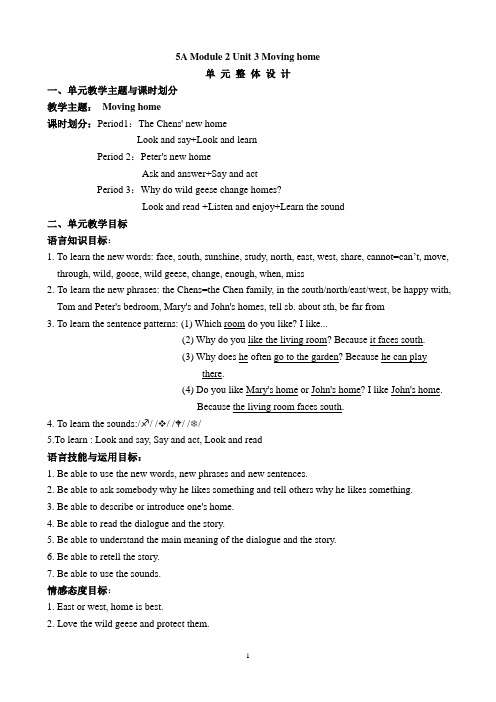
5A Module 2 Unit 3 Moving home单元整体设计一、单元教学主题与课时划分教学主题:Moving home课时划分:Period1:The Chens' new homeLook and say+Look and learnPeriod 2:Peter's new homeAsk and answer+Say and actPeriod 3:Why do wild geese change homes?Look and read +Listen and enjoy+Learn the sound二、单元教学目标语言知识目标:1. To learn the new words: face, south, sunshine, study, north, east, west, share, cannot=can’t, move, through, wild, goose, wild geese, change, enough, when, miss2. To learn the new phrases: the Chens=the Chen family, in the south/north/east/west, be happy with, Tom and Peter's bedroom, Mary's and John's homes, tell sb. about sth, be far from3. To learn the sentence patterns: (1) Which room do you like? I like...(2) Why do you like the living room? Because it faces south.(3) Why does he often go to the garden? Because he can playthere.(4) Do you like Mary's home or John's home? I like John's home.Because the living room faces south.4. To learn the sounds:/♐/ /❖/ / / /❆/5.To learn : Look and say, Say and act, Look and read语言技能与运用目标:1. Be able to use the new words, new phrases and new sentences.2. Be able to ask somebody why he likes something and tell others why he likes something.3. Be able to describe or introduce one's home.4. Be able to read the dialogue and the story.5. Be able to understand the main meaning of the dialogue and the story.6. Be able to retell the story.7. Be able to use the sounds.情感态度目标:1. East or west, home is best.2. Love the wild geese and protect them.5A Module 2 Unit 3 Moving home 第一课时漕泾小学陆文敏单课话题:The Chens' new homeKnowledge objectives:1. Help students to master the new words: south, north, east, west, face, sunshine, study,2. Help students to master the sentence: 1) Which room do you like? I like...2) Why do you like...? Because...3. Help students to master the dialogue of P27Skill objectives:1. Help students to pronounce the new words and speak the new sentences correctly.2. Help students to describe one's home or introduce it with the new words.3. Help students to ask somebody why he likes something and tell others why he likes something. Emotion objectives: East or west, Home is best.Teaching process:I. Pre-task:1. Daily talk:Who is your good friend?Are you in the same school?Does your friend live near school?How does your friend go to school?Do you like the same sports?When do you often play together?2. Revision:A. Read and arrange._________________ _________ ✈_______________ _________◆________________ ________ ☺_______ ________ ________room park us put bath son cook school duck foot class tooB. Fill in the blanks with the given words in their proper forms1) Don’t ________ (make) any noise . The little baby _________ (sleep).2) What time ______ your teacher _______ (go) to school ? At seven o’clock.3) Ben ________ (not watch) TV in the evening . He often_______(read) books .4) Draw different ________ (fly) on the paper .5) What’s the date today? It’s the _________ (two) of May.6) My little sister _________(like)__________ (drink) coffee .7) These ________(doctor) offices are clean .8) ______(who) pencil-case is that? It’s _________ (Tom).C. Say a chant1) e.g. How many rooms are there in the house? Let’s count.One room, two rooms, three rooms, four rooms.There are four rooms in the house.How many beds are there in the room? Let’s count.One bed, two beds.There are two beds in the room.……3) Make some riddles to review different places at home.II. While-task:一、New words: north, east, south, west再构文本:The Chens have a new home. It is very lovely. It is on West Garden Road. There is a supermarket near their home. It is on East Garden Road. It is very big. They can buy many different things there. There is a library near their home too. It is on North Park Road. It is bright, clean and quiet. Sally likes reading books in it. And there is also a school near their home. It is on South Park Road. Sally goes to school by bus from Monday to Friday.Little reporter interviews the Chens(小记者Kitty采访陈先生一家)1. To learn: west, east, north, south(1) Show the text passage by passage(2) Show the new words(3) Help students to read the new words and understand them(4) Ask some questions.2. Game Time(游戏互动)Play a game: What is missing?3. Walk around the house(参观陈先生新家)Play a game: Quick responseT: Face north, please.二、Sentences: (1)Which room do you like? I like...(2)Why do you like...? Because...1. Listen to the text and ask some questions.Little reporter asks: Which room does Sally like? Why does she like it?Which room does Mr Chen Like? Why does he like it?Sally likes __________ because ______________.Dad likes __________ because ______________.2. Let’s be little reportersAsk and answer in pairs.--Which room do you like? --I like...--Why do you like...? --Because...3. Language points:the Chens= the Chen familymove e.g. move home move the deskbe happy with sth. e.g. Are you happy with our new home?face south e.g. The living room faces south.a lot of books = many booksa lot of sunshine = much sunshineall daystudy e.g. I can study in my study.4. Read the dialogue of P27.III. Post-task1. Read the text and fill in the blanksThe Chens have a ______ home. Sally is ______ with their new home. She likes the ________ room. Because it’s ________ south. There’s _________ sunshine. Mr Chen likes the _________. Because it’s _________. He can ________ books there. Ben and Peter _________ their new home too. They can ________ in the garden ______ ________.2. Do a surveyDad likes their new home because ______________.Sally likes their new home because ______________.Peter likes their new home because ______________.3. ExercisesRewrite the following sentences.Model : I like the reading room. Which room do you like?1) They like the living room. ____________________________?2) I like the long ruler. ____________________________?3) Kitty wants the red ball. ____________________________?4) My sister wants the pen beside the book. __________________________?IV. Homework1. Read and recite the dialogue of P27.2. Copy the new words and phrases.3. Do some exercises.5A Module 2 Unit 3 Moving home 第二课时漕泾小学陆文敏单课话题:Peter' new homeKnowledge objectives:1. To learn the new words: share, through the window, be far from2. To learn the new sentence: How’s your new home?It only takes (me) 20 minutes (to go to school) by bus.Skill objectives:1. Help students to pronounce the words and sentences correctly:2. Help students to use the new words and sentences to communicate with others.3. Help students to ask somebody why he likes something and tell others why he likes something.4. Help students to describe Peter’s new home.Emotion objectives:East or west, home is best.I. Pre-task1. Daily talkDo you like the Chen’s new home?Which room does Sally like? Why?Does Dad like the study? Why?Where are Peter and Paul?Do they like their new home? Why?2. Try to describe the Chen’s new home.The Chens have a ______ home. Sally is ______ with their new home. She likes the ________ room. Because it’s________ south. There’s _________ sunshine. Mr Chen likes the _________. Because it’s _________. He can ________ books there. Ben and Peter _________ their new home too. They can ________ in the garden ______ ________.3. RevisionA. Fill in the blanks with the given verbs in their proper forms.1) There ________ ( be ) a lot of sunshine.2) What about _______ (go) on an outing?3) My new bedroom ________ (face) south.4) John’s brother likes both _________ (dog).B. Rewrite the following sentences.1) I like this sofa because it’s very soft. (划线提问)______ _______ you like this sofa?2) Tom doesn’t like the soup because it’s cold._____ ______ Tom like the soup?3) There is a lot of sunshine in the big room.(同义句转换)There is _______ sunshine in the big room.4) The Chens have a new room. (划线提问)_____ ______ the Chens ________?II.While –taskHome Economic ClubLittle reporter: I’ve invervied the Chen’s new home. It’s so nice! Today, let’s have a race. Introduce our own homes and design a better one.1. Text1) Elicit the textLittle reporter: The Chens have a new home. Peter is happy with his new home. Now he is telling Danny about his new home. Let’s watch the flash together and try to answer the following questions.Little reporter: now members of the club, try to be little reporters. Interview the others.Q: How’s Peter’s new home?How many bedrooms are there?Does Peter like his room?Why does he like it?Is his new home far from school?2. Language pointsshare share sth. with sb. e.g. Min shares the fish with Mog.tell tell sb. about sth. e.g. Peter is telling Danny about his new home.through through the window e.g. The sun shines through the window.far be far from e.g. Peter’s home is not far from school.take e.g. It only takes 20 minutes by bus.It only takes me 20 minutes (to go to school) by bus.3. Read the text4. Read the dialogue again and fill in the blanks.Peter’s home i s n_______ his school. It only t______ him 20 minutes by bus. There are t_____ rooms . Paul and Peter s_____ a bedroom. He likes his room b__________ it faces s_______. The sun shines t________ the window in the morning. His home is very n_______.5. Design your dream homeTry to act out the dialogue.III. Post –task1. Put the following phrases into Englisha. 朝北________________b. John的新家______________________c. 哪间房间__________________d. 在南方________________________e. 远离学校________________f. 穿过窗户_____________________2. Rewrite the following sentences.a. I like Mary’s room. (John’s room,选择疑问句)__________________________________________________________?b. I’m a doctor. (nurse, 选择疑问句)__________________________________________________________?c. There is a butterfly on the flower. (对划线部分提问)_________________________________________________________?d. My skateboard is nice. (对划线部分提问)_________________________________________________________?e. I like the living room because it faces south. (对划线部分提问)__________________________________________________________?IV. Homework:1. Read and act out the text.2. Do the exercises.3. Try to describe Peter’s new home.5A Module2 Unit 3 Moving homeThe 3rd Period (P30)第三课时漕泾小学李艳丽单课话题:Why do wild geese change homes?Knowledge objectives:1. Help the students to learn the new words and new phrases: wild, geese, change, twice, enough, miss, must, get; wild geese, change home, twice every year, enough food, miss their home2. Using wh-questions to ask reason: Why do wild geese change home? Why …?3. To learn the story:Why do wild geese change homes?4. Have the students listen to the rhyme for “Listen and enjoy”5. Help the students know the sounds of /f/,/v/,…in words.Skill objectives:4.Be able to read the story and listen and enjoy.5.Be able to understand the main meaning of the story.6.Be able to retell the story.Emotion objectives:Love our homes, love the wild geese.Steps of teaching:I. Pre-task1. Warming up (P31 Listen and enjoy)2. Daily talk (About your home)How is your home?How many bedrooms are there?Do you like your bedroom?Why?3. Revision:A. Read the passage and fill in the blanksPeter’s new homePeter’s home is n_______ his school. It only t______ him 20 minutes by bus. There aret_____ rooms. Paul and Peter s_____ a bedroom. He likes his room b__________ it facess_______. The sun shines t________ the window in the morning. His home is veryn_______.1) __________ is your cousin? ---She’s five.2) __________ are you today? Much better.3) __________is your new dress? One hundred yuan ..4) __________do you visit your grandparents? Once a week.5) __________do you do your homework every day? About 50 minutes.6) __________room does your brother like? The study.7) __________ is the man in white? He’s my uncle.8) __________do you want to buy a new watch? ----Because my watch is too old.4. Talk about your dream home.II. While –task:再构文本: People usually change their homes. Some animals change homes. And they change their homes every year. Such as, wild geese change their homes every year. Sometime they live in the north. Sometimes they live in the south. In autumn, they feel cold and they can not find enough food in the north. They fly to the south and live in the south. When spring comes, it is warm. They will fly back. And they miss their home. So wild geese change their homes twice a year. We call wild geese are migratory birds.The bird lover interviews the students. (Do you know the migratory birds? 采访学生是否知道候鸟,大雁就一种候鸟。
五年级上册英语教案-Module3Unit2EasterisinspringintheUK

五年级上册英语教案Module 3 Unit 2 Easter is in spring in the UK.一、教学目标1. 知识与技能:通过本课的学习,学生能够理解并掌握关于英国复活节的日期、天气、活动和食物的词汇和表达方式,如“Easter”,“spring”,“hot cross buns”等;能够运用所学知识描述英国的复活节情景。
2. 过程与方法:通过小组合作、角色扮演等活动,提高学生的英语听说能力和团队合作能力;通过观看视频、图片等资料,增强学生的文化意识。
3. 情感态度与价值观:通过了解英国的复活节文化,培养学生的跨文化交际意识,增进对英语国家的了解和尊重。
二、教学内容1. 词汇:Easter,spring,hot cross buns等。
2. 句型:Easter is in spring in the UK. It's warm in spring. People eat hot cross buns at Easter.三、教学重点与难点1. 教学重点:掌握关于英国复活节的日期、天气、活动和食物的词汇和表达方式;能够运用所学知识描述英国的复活节情景。
2. 教学难点:正确运用所学词汇和句型描述英国的复活节情景;理解英国的复活节文化。
四、教具与学具准备1. 教具:多媒体课件、视频、图片等。
2. 学具:单词卡片、练习册等。
五、教学过程1. 导入:通过播放关于英国复活节的视频,引起学生的兴趣,导入本课的话题。
2. 新课呈现:通过展示图片、实物等,引导学生学习关于英国复活节的词汇和表达方式。
3. 操练:通过小组合作、角色扮演等活动,让学生练习运用所学知识描述英国的复活节情景。
4. 巩固:通过完成练习册、单词卡片等,巩固所学知识。
六、板书设计1. 在黑板上列出本课的重点词汇和句型,并配以相应的图片或简笔画。
2. 在板书的右侧列出本课的教学目标、教学内容和教学重难点。
七、作业设计1. 完成练习册的相关练习。
五年级上册英语教案Module3Unit2Easterisinspring1外研社

Module 3U nit 2 Easter is in spring in the UK.◆ 教材剖析本模块的学习要点是认识并介绍西方的节日。
学生将要点学习与节日有关的词汇以及“It is ...People do ...等介绍节”日的构造。
经过学习这一模块,学生能够加深对西方民俗文化的认识,进一步感知中外文化的异同。
◆ 教课目的【知识目标】1、单词: Easter, chick, chocolate2、句型: Easter is in spring in the UK.3、运用已学语言描绘节日。
【能力目标】通太短文认识西方节日的基本状况,能够进行口头介绍或书面介绍所学习的西方节日。
【感情目标】在多种教课资源中认识西方节日,加深对西方民俗文化的认识,乐于接触外国文化,进一步感知中外文化的异同。
◆ 教课重难点◆【教课要点】1、听闻读用单词: Easter, give, chocolate, sometimes2、能听懂、读说句子:Easter is in spring in the UK. People give childrenchocolate eggs.【教课点】能运用已学言描绘西方日的俗。
◆ 课前准备◆Tape recorder, MultimediaStep 1 Warm-upTeacher: Hello, boys and girls. Last lesson we learned a festival. Have you still remembered the festival name?’sStudents answer: It lloween’sHa.Step 2 Presentation1.(PPT: a picture of some people wearing Easter hats.)Teacher: Look, What do they wear?Students answer: They wear hats.2.Teacher: What can you see on the hats?Show a picture to lead Ss say: There are⋯3.Teacher: Do you know why?Let ’slisten and find out the answer.4.What do you want to know about Easter? Let Ss say. Then show some questions and lead Ss find the answers from reading the text and discussing in groups.5.Teacher: Easter egg is one of the Easter sign. There are manyEaster signs. Let ’s have a lookShow. a picture.Step 3 Drills1.Listen and imitate.2.Enjoy a chant.察看内容的选择,我本着先静后动,由近及远的原则,有目的、有计划的先安排与少儿生活靠近的,能理解的察看内容。
2024年外研版英语五年级上册教案外研5上教案Module3unit 2第一课时
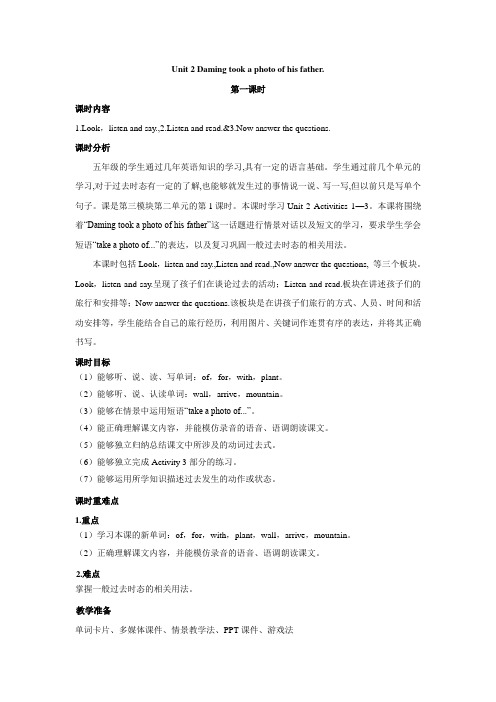
Unit 2 Daming took a photo of his father.第一课时课时内容1.Look,listen and say.,2.Listen and read.&3.Now answer the questions.课时分析五年级的学生通过几年英语知识的学习,具有一定的语言基础。
学生通过前几个单元的学习,对于过去时态有一定的了解,也能够就发生过的事情说一说、写一写,但以前只是写单个句子。
课是第三模块第二单元的第1课时。
本课时学习Unit 2 Activities 1—3。
本课将围绕着“Daming took a photo of his father”这一话题进行情景对话以及短文的学习,要求学生学会短语“take a photo of...”的表达,以及复习巩固一般过去时态的相关用法。
本课时包括Look,listen and say.,Listen and read.,Now answer the questions, 等三个板块。
Look,listen and say.呈现了孩子们在谈论过去的活动;Listen and read.板块在讲述孩子们的旅行和安排等;Now answer the questions.该板块是在讲孩子们旅行的方式、人员、时间和活动安排等,学生能结合自己的旅行经历,利用图片、关键词作连贯有序的表达,并将其正确书写。
课时目标(1)能够听、说、读、写单词:of,for,with,plant。
(2)能够听、说、认读单词:wall,arrive,mountain。
(3)能够在情景中运用短语“take a photo of...”。
(4)能正确理解课文内容,并能模仿录音的语音、语调朗读课文。
(5)能够独立归纳总结课文中所涉及的动词过去式。
(6)能够独立完成Activity 3部分的练习。
(7)能够运用所学知识描述过去发生的动作或状态。
课时重难点1.重点(1)学习本课的新单词:of,for,with,plant,wall,arrive,mountain。
5Aunit3第二课时教案
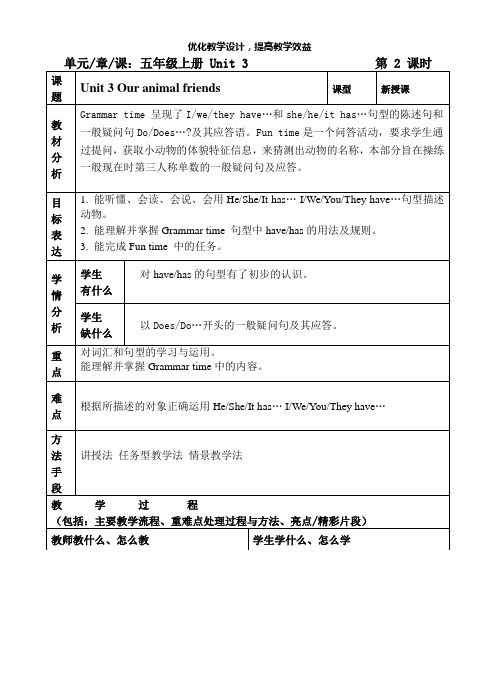
单元/章/课:五年级上册 Unit 3 第 2 课时课题Unit 3 Our animal friends 课型新授课教材分析Grammar time 呈现了I/we/they have…和she/he/it has…句型的陈述句和一般疑问句Do/Does…?及其应答语。
Fun time是一个问答活动,要求学生通过提问,获取小动物的体貌特征信息,来猜测出动物的名称,本部分旨在操练一般现在时第三人称单数的一般疑问句及应答。
目标表达1. 能听懂、会读、会说、会用He/She/It has… I/We/You/They have…句型描述动物。
2. 能理解并掌握Grammar time 句型中have/has的用法及规则。
3. 能完成Fun time 中的任务。
学情分析学生有什么对have/has的句型有了初步的认识。
学生缺什么以Does/Do…开头的一般疑问句及其应答。
重点对词汇和句型的学习与运用。
能理解并掌握Grammar time中的内容。
难点根据所描述的对象正确运用He/She/It has… I/We/You/They have…方法手段讲授法任务型教学法情景教学法教学过程(包括:主要教学流程、重难点处理过程与方法、亮点/精彩片段)教师教什么、怎么教学生学什么、怎么学Step 1: Revision1. Play a game:Listen and touch组织学生复习身体部位单词2. Look and say:比如:Nancy has two fish. One is … the other is… They have… They can…教师出示4张动物图片,引导学生通过观察,回忆课文。
Step 23:自主、合作学习学习Grammar time1. Read the sentences1) I have two fish.…He has a dog.…2) 合作讨论:仔细读句子,关注主语,思考:何时使用have?何时使用has ?(呈现书本P29第1个语法图表,引导学生观察、总结have/has)3)Read and try to complete the sentences.Mike ____ a nice picture.I _____ a happy family!They _______ a lot of books.It ____ two wings.引导学生注意倾听,分清在不同的人称代词后面正确运用have/has。
五年级英语上册5A Module 3 Unit 2教案
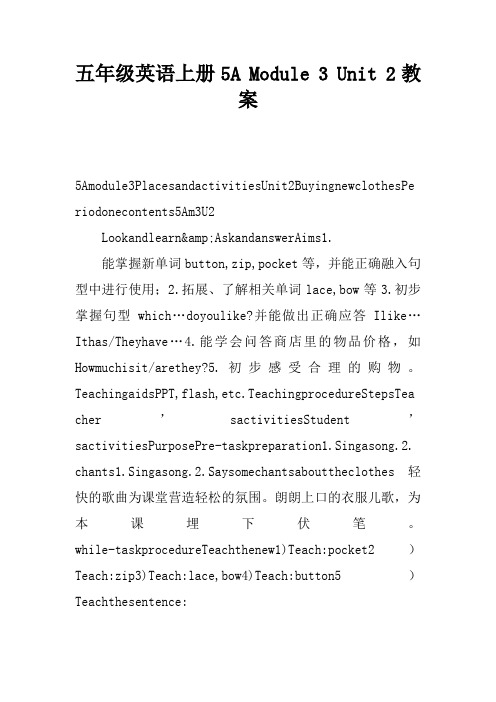
五年级英语上册5A Module 3 Unit 2教案5Amodule3PlacesandactivitiesUnit2BuyingnewclothesPe riodonecontents5Am3U2Lookandlearn&AskandanswerAims1.能掌握新单词button,zip,pocket等,并能正确融入句型中进行使用;2.拓展、了解相关单词lace,bow等3.初步掌握句型which…doyoulike?并能做出正确应答Ilike…Ithas/Theyhave…4.能学会问答商店里的物品价格,如Howmuchisit/arethey?5.初步感受合理的购物。
TeachingaidsPPT,flash,etc.TeachingprocedureStepsTea cher’sactivitiesStudent’sactivitiesPurposePre-taskpreparation1.Singasong.2. chants1.Singasong.2.Saysomechantsabouttheclothes轻快的歌曲为课堂营造轻松的氛围。
朗朗上口的衣服儿歌,为本课埋下伏笔。
while-taskprocedureTeachthenew1)Teach:pocket2)Teach:zip3)Teach:lace,bow4)Teach:button5)Teachthesentence:Howmuch…?1.Askandanswer:Intheclothesshop,whatcanyo usee?2.jacketàpocket3.pocketmoney4.what’sinthepockets?Some______inthepockets.1.Readandjudge2.Learnthenewword:zip3.halfzip&zipup4.wherecanyouseethezip?whichdressdoyoulike?Ili ke…Ithas…1.Guessgames2.Learnthenewword3.Readthenewchant4.wherecanyouseethebutton?1.Askandanswer:which…doyoulike?Ilikethe…one.Ithas….Howmuchisit?Itis...yuan.2.Learnthenew;p rice,RmB,pound,dollar,Euro.3.apairof4.Askandanswer: which…doyoulike?Ilikethe…ones.Theyhave….Howmucharethey?Theyare...yuan.创设情境,帮助学生回忆与衣服相关的旧知,为新授内容作铺垫。
新深圳牛津小学英语五年级上册教案
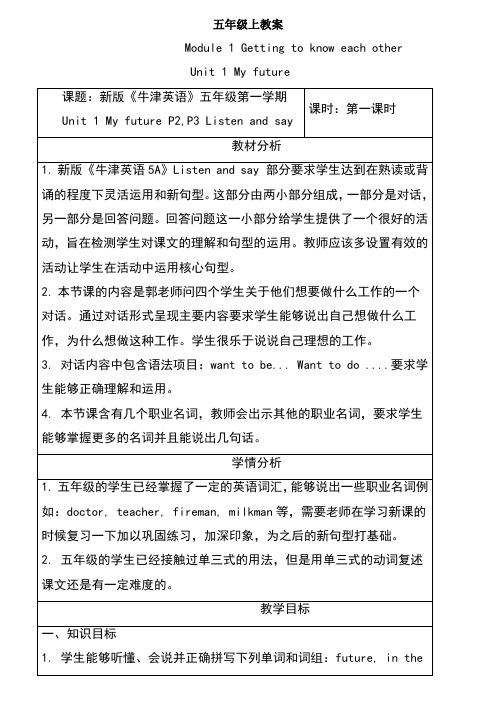
五年级上教案Module 1 Getting to know each other Unit 1 My futureUnit 1 My future 第二课时一、Pre-task preparations1. 学生或教师准备一些亲人或朋友的图片,向班级展示并进行描述。
S1: This is my uncle. He can cook well. Helikes cooking. He works in a restaurant.He is a cook.S2: This is my mother. She likes Chinese. She works in a school.She is a Chinese teacher.(2)使用本单元的核心句型及词汇引领学生朗诵儿歌。
教师出示不同工作的照片或词卡,引导学生把单词套入歌谣中。
What do you, what do you, what do you want to beI want to, I want to, I want to be a /an ...What do you, what do you, what do you want to beI want to, I want to, I want to be a /an ...二、While-task procedures1. 听Listen and say 的录音,学生回答问题。
1) What does Peter want to be (He wants to be a pilot.)2) What do pilots do They fly planes.3) What does Kitty want to be (She wants to be a doctor.)4) What do doctors do (They help (sick) people.)5) What does Alice want to be (She wants to be a teacher.) 6) What do teachers do (They teach students.)7) What does Joe want to be (He wants to be a cook.)8) What do cooks do (They cook nice food.)学生两人一组完成课本第3 页Listen and say的后续练习,巩固其内容。
五年级上册英语教案-Module3Unit2EasterisinSpringintheUK
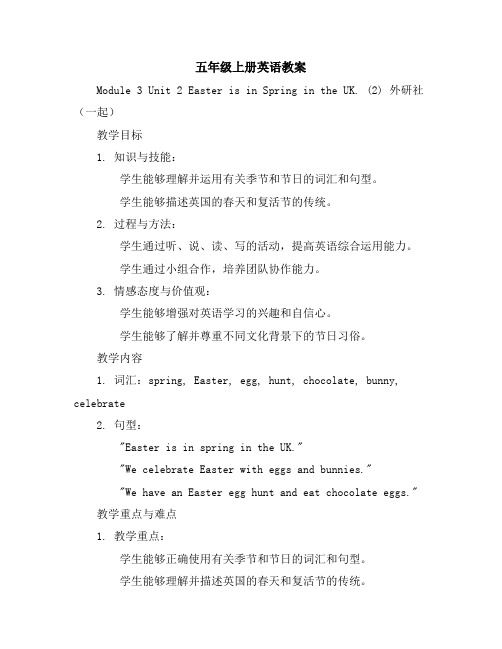
五年级上册英语教案Module 3 Unit 2 Easter is in Spring in the UK. (2) 外研社(一起)教学目标1. 知识与技能:学生能够理解并运用有关季节和节日的词汇和句型。
学生能够描述英国的春天和复活节的传统。
2. 过程与方法:学生通过听、说、读、写的活动,提高英语综合运用能力。
学生通过小组合作,培养团队协作能力。
3. 情感态度与价值观:学生能够增强对英语学习的兴趣和自信心。
学生能够了解并尊重不同文化背景下的节日习俗。
教学内容1. 词汇:spring, Easter, egg, hunt, chocolate, bunny, celebrate2. 句型:"Easter is in spring in the UK.""We celebrate Easter with eggs and bunnies.""We have an Easter egg hunt and eat chocolate eggs."教学重点与难点1. 教学重点:学生能够正确使用有关季节和节日的词汇和句型。
学生能够理解并描述英国的春天和复活节的传统。
2. 教学难点:学生能够正确运用一般现在时描述节日的习俗。
学生能够理解并运用定语从句来描述物品。
教具与学具准备1. 教具:PPT,录音机,黑板2. 学具:学生用书,练习册,彩笔教学过程1. 导入:通过展示春天的图片,引导学生谈论春天的特点和活动。
2. 新课呈现:通过PPT展示英国的春天和复活节的图片,引导学生学习新词汇和句型。
3. 操练:通过小组活动,让学生练习使用新学的词汇和句型。
4. 应用:通过角色扮演,让学生模拟在英国过复活节的情景。
板书设计1. Module 3 Unit 2 Easter is in Spring in the UK.2. 关键词汇和句型:spring, Easter, egg, hunt, chocolate, bunny, celebrate"Easter is in spring in the UK.""We celebrate Easter with eggs and bunnies.""We have an Easter egg hunt and eat chocolate eggs."作业设计1. 学生用书P5657,练习A和B2. 写一篇关于自己最喜欢的季节或节日的短文课后反思通过本课的学习,学生能够理解并运用有关季节和节日的词汇和句型,描述英国的春天和复活节的传统。
五年级英语上册5A Module 3 Unit 2教案
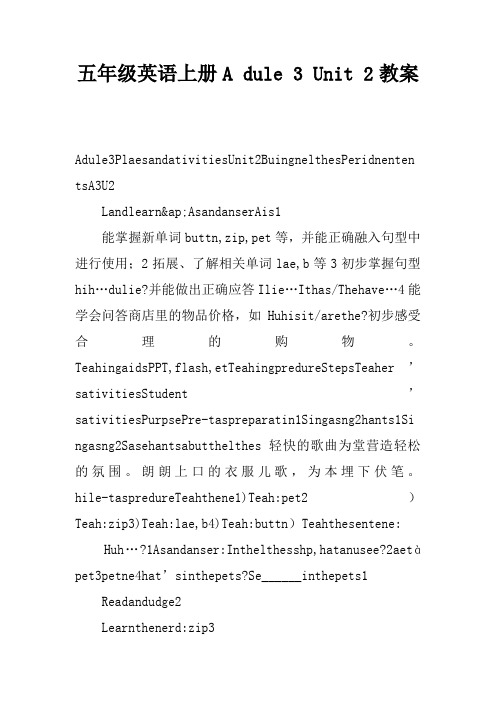
五年级英语上册A dule 3 Unit 2教案Adule3PlaesandativitiesUnit2BuingnelthesPeridnenten tsA3U2Landlearn≈AsandanserAis1能掌握新单词buttn,zip,pet等,并能正确融入句型中进行使用;2拓展、了解相关单词lae,b等3初步掌握句型hih…dulie?并能做出正确应答Ilie…Ithas/Thehave…4能学会问答商店里的物品价格,如Huhisit/arethe?初步感受合理的购物。
TeahingaidsPPT,flash,etTeahingpredureStepsTeaher’sativitiesStudent’sativitiesPurpsePre-taspreparatin1Singasng2hants1Si ngasng2Sasehantsabutthelthes轻快的歌曲为堂营造轻松的氛围。
朗朗上口的衣服儿歌,为本埋下伏笔。
hile-taspredureTeahthene1)Teah:pet2)Teah:zip3)Teah:lae,b4)Teah:buttn)Teahthesentene: Huh…?1Asandanser:Inthelthesshp,hatanusee?2aetàpet3petne4hat’sinthepets?Se______inthepets1 Readandudge2Learnthenerd:zip3halfzip≈zipup4hereanuseethezip?hihdressdulie?Ilie...Ithas (1)Guessgaes2Learnthenerd3Readthenehant4hereanuseethebuttn?1Asandanser:hih…dulie?Iliethe…neIthas…Huhisit?Itisuan2Learnthene;prie,RB,pund,dllar,Eur3a pairf4Asandanser:hih…dulie?Iliethe…nesThehave…Huharethe?Theareuan创设情境,帮助学生回忆与衣服相关的旧知,为新授内容作铺垫。
五年级上册英语教案Module 3 Unit 2 Daming took a photo of his father外研社(三起)
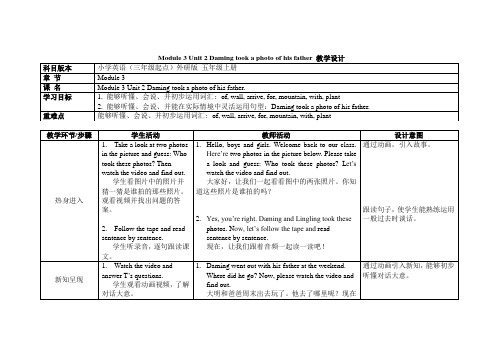
4.Listen and underline the letters that make the sound. Then say the words.
学生听录音,划出发音的字母。然后大声说一说。
5. Check the answers
学生核对答案。
6.Learn a song. First,listen to the lyrics and try to repeat.
学生看图片中的照片并猜一猜是谁拍的那些照片。观看视频并找出问题的答案。
2.Follow the tape and read sentence by sentence.
学生听录音,逐句跟读课文。
1.Hello, boys and girls. Welcome back to our class. Here’re two photos in the picture below. Please take a look and guess: Who took these photos?Let’s watch the video and find out.
练习陈述过去发生的事。Biblioteka 小组活动练习陈述过去发生的事。
能在实际情境中运用所学的句型。调查一下同学们的旅行。
作业布置
今天我们学习了如何谈论周末生活,大家都学会了吗?课后就让我们用学过的句子跟家人讨论一下吧!
课堂内容小结
进步标志
1.能够听懂、会说、并初步运用词汇:of, wall, arrive, for, mountain, with, plant
四个同学一个小组,其中三位同学分别从盒子里选出一个词汇,第四名同学试着造一个句子。
3. Make a survey of trips.
外研社五年级英语上册教案设计Module3-Unit2《Easter-is-in-spring.2》

外研社五年级英语上册教案设计Module3 Unit2《Easter is in spring.2》外研社五年级英语上册教案设计Module3 Unit2《Easter is in spring.2》一、教学目标:1、知识技能目标:(1) 能熟练掌握以下单词:春天(spring)夏天(summer)秋天(autumn)复活节(Easter)帽子(hat)鸡蛋(egg)巧克力(chocolate)短语:Easter hats, small eggs, in the big eggs能熟练掌握以下句子:There are toy chicks and flowers on the Easter hats. Easter is in spring. People give children chocolate eggs.We are learning the months of the year.(2) 模拟复活节场景下,能进行简单的英语交流和表演。
能在情景中灵活运用本节课所学内容表达自己的意愿。
能初步运用句型 a、There are toy chicks and flowers on the Easter hats. b、Easter is in spring. People give children chocolate eggs. c、We are learning the months of the year. 进行交流,能替换短语进行对话练习。
(3) 鼓励学生用“wh”词质疑。
如:“What do they eat on Easter?”“Why is there the Easter?”“Where do they go on Easter?”“When is Easter?”2、情感态度目标:整节课教师以Easter为主线,让学生在真实的情景中接触语言材料,感受语言知识,通过各种活动,促进学生语言技能的发展。
5Aunit3第二课时教案
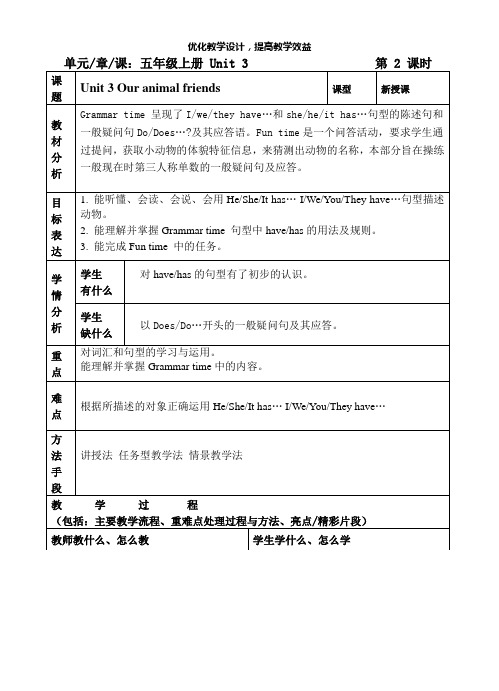
课题
Unit 3 Our animal friends
课型
新授课
教
材
分
析
Grammar time 呈现了I/we/they have…和she/he/it has…句型的陈述句和一般疑问句Do/Does…?及其应答语。Fun time是一个问答活动,要求学生通过提问,获取小动物的体貌特征信息,来猜测出动物的名称,本部分旨在操练一般现在时第三人称单数的一般疑问句及应答。
三、阅读P31的culture time,了解各国的一些特有的动物品种。
反思与 重建
学生在认真读句子的基础上,和同桌交流Does/Do开头一般疑问句的用法,并通过观察、总结如何将有have/has的句子变为一般疑问句,并作答。
学生在采访获取相关信息后,试着根据信息内容来描述小组内某一成员的“动物朋友”。
学习自主完成练习。
课堂
巩固
训练
一、选择(have/has填空) (试着说说为什么?)
2)合作讨论:仔细读句子,关注以Do/Does开头的一般疑问句后的主语,思考:如何将有have/has的句子变为一般疑问句,如何作答?
(呈现书本P29第2个语法图表,引导学生观察思考)
学习Fun time
1.T:Do you have an animal friend ?
S: Yes ,Ido .
T: Does it have…?
3)Readand try to complete the sentences.
Mike ____ a nice picture.
I _____ a happy family!
They _______ a lot of books.
五年级上册英语教案-Module3Unit2Easterisinspring1|外研社(一起)

五年级上册英语教案Module 3 Unit 2 Easter is in spring1|外研社(一起)一、教学目标1. 知识与技能:(1)学生能够理解课文内容,掌握本节课的重点单词和短语,如:Easter, spring, egg, chocolate, rabbit等。
(2)学生能够运用本节课所学的句型描述复活节的习俗和活动。
(3)学生能够正确朗读课文,并进行角色扮演。
2. 过程与方法:(1)通过图片、视频等教学资源,激发学生的学习兴趣,帮助学生更好地理解课文内容。
(2)通过小组讨论、角色扮演等活动,培养学生的合作意识和口语表达能力。
3. 情感态度与价值观:(1)培养学生对英语学习的兴趣和自信心。
(2)引导学生了解和尊重不同文化背景下的节日习俗。
二、教学内容1. 课文内容:Module 3 Unit 2 Easter is in spring 12. 教学重点:单词和短语:Easter, spring, egg, chocolate, rabbit等。
3. 教学难点:句型:Easter is in spring. We can see many eggs/chocolates/rabbits at Easter.三、教具与学具准备1. 教具:PPT、视频、图片等教学资源。
2. 学具:单词卡片、句型卡片、练习册等。
四、教学过程1. 导入:通过展示复活节的图片和视频,引导学生了解复活节的习俗和活动,激发学生的学习兴趣。
2. 新课内容展示:利用PPT展示课文内容,引导学生学习本节课的重点单词和短语,如:Easter, spring, egg, chocolate, rabbit 等。
3. 句型学习:通过句型卡片,引导学生学习本节课的句型:Easter is in spring. We can see many eggs/chocolates/rabbits at Easter.4. 小组讨论:学生分组讨论,运用本节课所学的单词和句型描述复活节的习俗和活动。
(小学教育)五年级英语上册 Module 3Unit 2 Let’s go shopping教案5
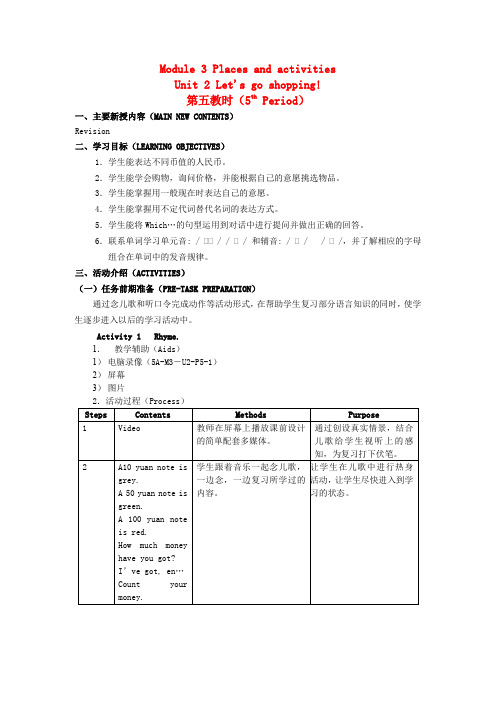
Module 3 Places and activitiesUnit 2 Let's go shopping!第五教时(5th Period)一、主要新授内容(MAIN NEW CONTENTS)Revision二、学习目标(LEARNING OBJECTIVES)1.学生能表达不同币值的人民币。
2.学生能学会购物,询问价格,并能根据自己的意愿挑选物品。
3.学生能掌握用一般现在时表达自己的意愿。
4.学生能掌握用不定代词替代名词的表达方式。
5.学生能将Which…的句型运用到对话中进行提问并做出正确的回答。
6.联系单词学习单元音: / / / / 和辅音: / / / /,并了解相应的字母组合在单词中的发音规律。
三、活动介绍(ACTIVITIES)(一)任务前期准备(PRE-TASK PREPARATION)通过念儿歌和听口令完成动作等活动形式,在帮助学生复习部分语言知识的同时,使学生逐步进入以后的学习活动中。
Activity 1 Rhyme.1.教学辅助(Aids)1)电脑录像(5A-M3-U2-P5-1)2)屏幕3)图片2.活动过程(Process)Activity 2 A guessing game.活动过程(Process)(二)任务实施过程(WHILE-TASK PROCEDURE)通过创设情景,复习巩固本单元所学习的内容,并指导学生完成练习册上的内容,提高学习能力。
Activity 1 (Quick response)1.教学辅助(Aids)1)电脑(5A-M3-U3-P5-2)2)屏幕Activity 2 (Making dialogues)Activity 3 (Group work )活动过程(Process)1.教学辅助(Aids)1)配套语法练习册Activity 4 (Exercises )活动过程(Process)1.教学辅助(Aids)1)配套语法练习册Activity 5 (Exercises )活动过程(Process)1.教学辅助(Aids)配套练习册3.任务后期完成阶段(Post-task activity section)在学生能够巩固所学知识的基础上,教师通过创设情景,提供阅读材料的手段,使学生能够将所学知识与生活实际相联系,并能学以致用。
五年级上册英语教案Module 3 Unit 2 Easter is in spring 2外研社
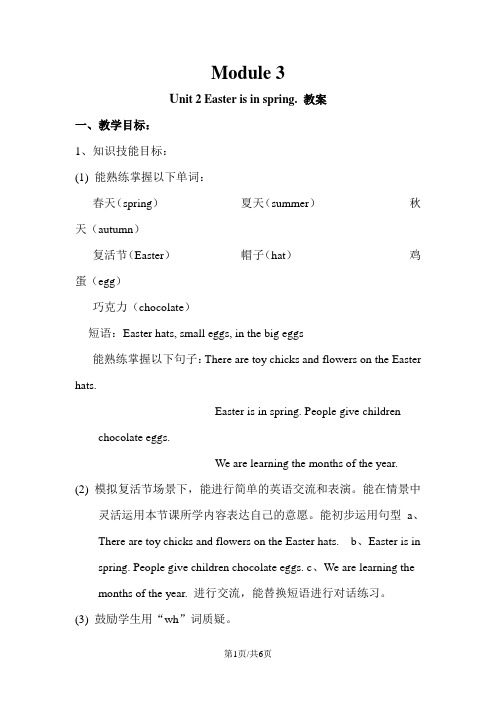
Module 3U nit 2 Easter is in spring. 教案一、教学目标:1、知识技能目标:(1) 能熟练掌握以下单词:春天(spring)夏天(summer)秋天(autumn)复活节(Easter)帽子(hat)鸡蛋(egg)巧克力(chocolate)短语:Easter hats, small eggs, in the big eggs能熟练掌握以下句子:There are toy chicks and flowers on the Easter hats.Easter is in spring. People give children chocolate eggs.We are learning the months of the year. (2) 模拟复活节场景下,能进行简单的英语交流和表演。
能在情景中灵活运用本节课所学内容表达自己的意愿。
能初步运用句型a、There are toy chicks and flowers on the Easter hats. b、Easter is in spring. People give children chocolate eggs. c、We are learning the months of the year. 进行交流,能替换短语进行对话练习。
(3) 鼓励学生用“wh”词质疑。
如:"What do they eat on Easter?""Why is there the Easter?""Where do they go on Easter?"“When is Easter?”2、情感态度目标:整节课教师以Easter为主线,让学生在真实的情景中接触语言材料,感受语言知识,通过各种活动,促进学生语言技能的发展。
在呈现时,通过视频展示有趣的复活节,呈现得比较自然,学生也容易理解。
外研版五年级英语上册Module3unit2Damingtookaphotoofhisfather教案精品
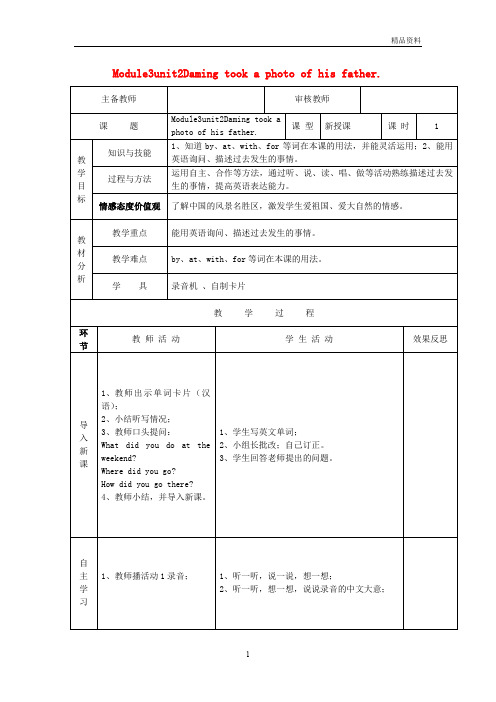
板书设计
Module3 unit2
Daming took a photo of his father.
1、过去式:2、词组:3、句子:
do-did……at the weekend……The wall is very old and very long.
take-took at ten o’clock Where did you go?
3、学生回答老师提出的问题。
自
主
学
习
1、教师播活动1录音;
1、听一听,说一说,想一想;
2、听一听,想一想,说说录音的中文大意;
小
组
合
作
1、说一说。教师出示复述提纲,学生合作练习复述;2、教师点拨重点的词语与句子;3、答一答。学生讨论后共同回答教师提出的问题:Who went to the great wall? How did they go there?When did they arrived?What did Daming do?4、唱一唱。学生讨论说一下本课歌曲大意,然后学唱歌曲。5、教师指导,学生合作,学习记忆活动4中字母组合的发音。6、造一造。小组学生合作,造一些滑稽的句子。7、共同说一下:我国都有哪些风景名胜区,它们分别有何特色?你最喜欢什么地方?我们的祖国美吗?
环节
教师活动
学生活动
效果反思
导
入
新
课
1、教师出示单词卡片(汉语);
2、小结听写情况;
3、教师口头提问:
What did you do at the weekend?
Where did you go?
How did you go there?
外研版五年级英语上册Module3unit2Damingtookaphotoofhisfather教案
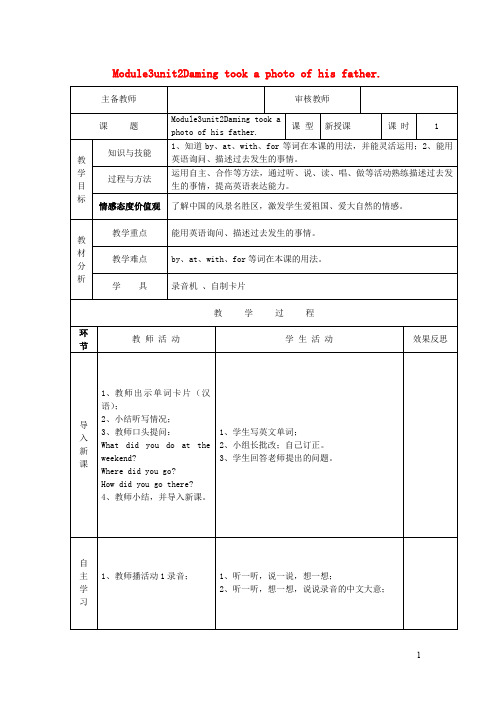
教师活动
学生活动
效果反思
导
入
新
课
1、教师出示单词卡片(汉语);
2、小结听写情况;
3、教师口头提问:
What did you do at the weekend?
Where did you go?
How did you go there?
4、教师小结,并导入新课。
1、学生写英文单词;
2、小组长批改;自己订正。
拓
展
训
练
以自己上周末的去向为内容进行对话,练习描述过去发生的事情。
作业设计
一、填空。
1、tomato(复数)__ 2、photo(复数)__ 3、take(过去式) __
4、do(过去式) __ 5、go(过去式)__
二、汉译英。
1、在周末;2、在十点钟;3、长着美丽花儿和绿色植物的山的照片;4、达1小时。
3、学生回答老师提出的问题。
自
主
学
习
1、教师播活动1录音;
1、听一听,说一说,想一想;
2、听一听,想一想,说说录音的中文大意;
小
组
合
作
1、说一说。教师出示复述提纲,学生合作练习复述;2、教师点拨重点的词语与句子;3、答一答。学生讨论后共同回答教师提出的问题:Who went to the great wall? How did they go there?When did they arrived?What did Daming do?4、唱一唱。学生讨论说一下本课歌曲大意,然后学唱歌曲。5、教师指导,学生合作,学习记忆活动4中字母组合的发音。6、造一造。小组学生合作,造一些滑稽的句子。7、共同说一下:我国都有哪些风景名胜区,它们分别有何特色?你最喜欢什么地方?我们的祖国美吗?
五年级上册英语教案Module 3 Unit 2 Easter is in spring 1外研社
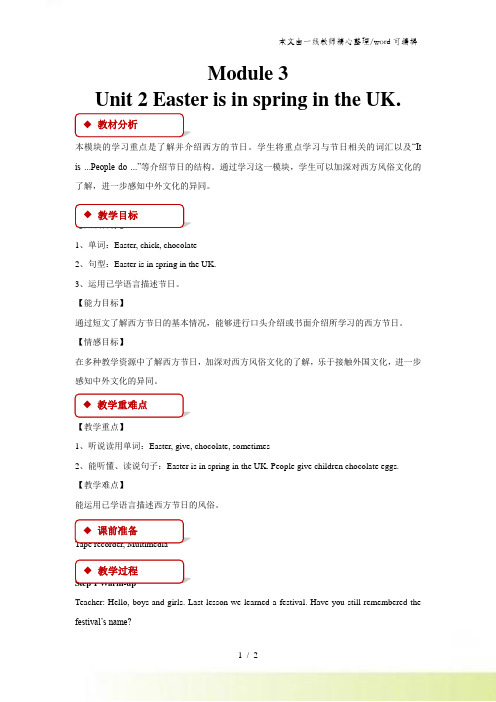
Module 3Unit 2 Easter is in spring in the UK. 本模块的学习重点是了解并介绍西方的节日。
学生将重点学习与节日相关的词汇以及“It is ...People do ...”等介绍节日的结构。
通过学习这一模块,学生可以加深对西方风俗文化的了解,进一步感知中外文化的异同。
【知识目标】1、单词:Easter, chick, chocolate2、句型:Easter is in spring in the UK.3、运用已学语言描述节日。
【能力目标】通过短文了解西方节日的基本情况,能够进行口头介绍或书面介绍所学习的西方节日。
【情感目标】在多种教学资源中了解西方节日,加深对西方风俗文化的了解,乐于接触外国文化,进一步感知中外文化的异同。
【教学重点】1、听说读用单词:Easter, give, chocolate, sometimes2、能听懂、读说句子:Easter is in spring in the UK. People give children chocolate eggs.【教学难点】能运用已学语言描述西方节日的风俗。
Tape recorder, Multimedia Step 1 Warm-upTeacher: Hello, boys and girls. Last lesson we learned a festival. Have you still remembered the festival’s name?◆ 教材分析◆ 教学目标◆ 教学重难点◆ ◆ 课前准备◆◆ 教学过程S tudents answer: It’s Halloween.Step 2 Presentation1. (PPT: a picture of some people wearing Easter hats.)Teacher: Look, What do they wear?Students answer: They wear hats.2. Teacher: What can you see on the hats?Show a picture to lead Ss say: There are …3. Teacher: Do you know why? Let’s listen and find out the answ er.4. What do you want to know about Easter? Let Ss say. Then show some questions and lead Ss find the answers from reading the text and discussing in groups.5. Teacher: Easter egg is one of the Easter sign. There are many Easter signs. Let’s have a look. Show a picture.Step 3 Drills1. Listen and imitate.2. Enjoy a chant.3. Read and choose.4. Find the differences about Halloween, Easter, Christmas and so on.Step 4 Homework1. Listen and repeat the text for three times.2. Tell your parents what festival have you learned.3. Make some more posters about festivals and introduce it to your friends!◆教学反思略。
小学五年级英语5AUnit3教学方案第二课时
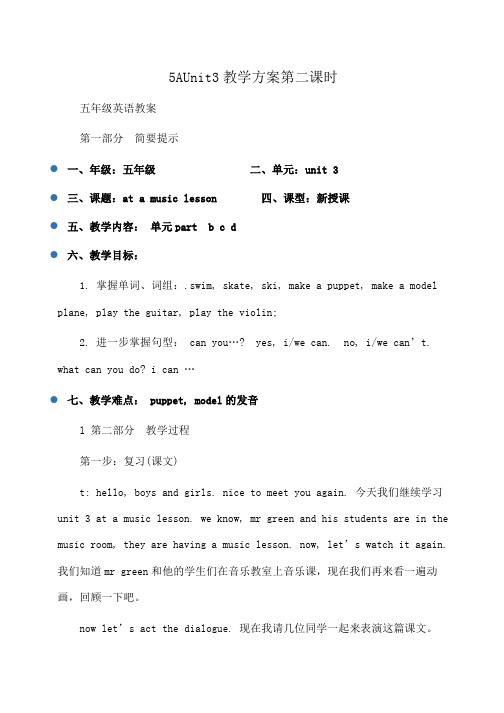
5AUnit3教学方案第二课时五年级英语教案第一部分简要提示●一、年级:五年级二、单元:unit 3●三、课题:at a music lesson 四、课型:新授课●五、教学内容:单元part b c d●六、教学目标:1. 掌握单词、词组:.swim, skate, ski, make a puppet, make a model plane, play the guitar, play the violin;2. 进一步掌握句型: can you…? yes, i/we can. no, i/we can’t. what can you do? i can …●七、教学难点: puppet, model的发音l 第二部分教学过程第一步:复习(课文)t: hello, boys and girls. nice to meet you again. 今天我们继续学习unit 3 at a music lesson. we know, mr green and his students are in the music room, they are having a music lesson. now, let’s watch it again. 我们知道mr green和他的学生们在音乐教室上音乐课,现在我们再来看一遍动画,回顾一下吧。
now let’s act the dialogue. 现在我请几位同学一起来表演这篇课文。
t: 表演完课文,我们再一起唱一唱上堂课学习的歌曲‘we can sing and dance’吧。
(播放歌曲)第二步:词汇学习1. t: 刚才我们复习了课文,还一起唱了一首歌,现在老师知道你们会唱歌,还会跳舞。
你们还会做什么呢?now please look at these pictures and words. what can you do? what can’t you do? 请先试着读一读这些单词和短语,然后想一想你会做什么,不能会什么。
- 1、下载文档前请自行甄别文档内容的完整性,平台不提供额外的编辑、内容补充、找答案等附加服务。
- 2、"仅部分预览"的文档,不可在线预览部分如存在完整性等问题,可反馈申请退款(可完整预览的文档不适用该条件!)。
- 3、如文档侵犯您的权益,请联系客服反馈,我们会尽快为您处理(人工客服工作时间:9:00-18:30)。
五年级英语上册5A Module 3 Unit 2教案5Amodule3PlacesandactivitiesUnit2BuyingnewclothesPe riodonecontents5Am3U2Lookandlearn&AskandanswerAims1.能掌握新单词button,zip,pocket等,并能正确融入句型中进行使用;2.拓展、了解相关单词lace,bow等3.初步掌握句型which…doyoulike?并能做出正确应答Ilike…Ithas/Theyhave…4.能学会问答商店里的物品价格,如Howmuchisit/arethey?5.初步感受合理的购物。
TeachingaidsPPT,flash,etc.TeachingprocedureStepsTea cher’sactivitiesStudent’sactivitiesPurposePre-taskpreparation1.Singasong.2. chants1.Singasong.2.Saysomechantsabouttheclothes轻快的歌曲为课堂营造轻松的氛围。
朗朗上口的衣服儿歌,为本课埋下伏笔。
while-taskprocedureTeachthenew1)Teach:pocket2)Teach:zip3)Teach:lace,bow4)Teach:button5)Teachthesentence:Howmuch…?1.Askandanswer:Intheclothesshop,whatcanyo usee?2.jacketàpocket3.pocketmoney4.what’sinthepockets?Some______inthepockets.1.Readandjudge2.Learnthenewword:zip3.halfzip&zipup4.wherecanyouseethezip?whichdressdoyoulike?Ili ke…Ithas…1.Guessgames2.Learnthenewword3.Readthenewchant4.wherecanyouseethebutton?1.Askandanswer:which…doyoulike?Ilikethe…one.Ithas….Howmuchisit?Itis...yuan.2.Learnthenew;p rice,RmB,pound,dollar,Euro.3.apairof4.Askandanswer: which…doyoulike?Ilikethe…ones.Theyhave….Howmucharethey?Theyare...yuan.创设情境,帮助学生回忆与衣服相关的旧知,为新授内容作铺垫。
从孩子的实际出发,通过小语段的阅读让学生理解零花钱的意思知道其作用,发挥学生的想象力。
与现实生活有机结合。
利用图片,在巩固新知的同时,拓展衣服装饰。
通过游戏,阅读语段,巩固新知,引出单词。
让孩子真正了解其不同情境下的不同意思。
让学生了解世界上几个大国所用的价格的符号。
让学生掌握衣服中复数的表达。
Post-taskactivities1.Sayandact2.FillintheblanksAska ndanswerThinkandwrite:Fillinthewordsbyreadingthesen tencesgiven.表演对话,对本课的新授单词进行全面的听说读写的巩固。
Homework1.Listenandreadthenewwords2.copythenewwords fourtimes.3.Sayandwrite“Askandanswer”,choosetwopictureyoulike.回家作业,听说读写四方面兼顾复习。
板书设计5Am3U2Buyingnewclotheswhich…doyoulike?Ilikethe…one/ones.pocketIthas/Theyhave…buttonHowmuchisit/arethey?zipItis/Theyare...yuan.lacebow教学反思PeriodTwocontents5Am3U2SayandactAims1.能掌握词组puton…tryon...toosmall,并能根据情景进行使用;2.拓展了解词组takeoff3.掌握句型which…doyoulike,the…oneorthe…one?并能做出正确应答Ilikethe…one.4.能根据情景用whynot…?向他人提出建议,并能回应Goodidea!TeachingaidsPPT,flash,etc.Teachingprocedur eStepsStudent’sactivitiesTeacher’sactivitiesPurposePre-taskpreparation1.Enjoytheflas handtrytosing.2.Reviewthechant3.ReadandguessT.Showa flash:ListenandenjoyTshowsthepicturesandsomepartsof thechants.Ssfinishthem.Readtheparagraphsandguessthe clothes.创设轻松愉快的坏境让学生进入学习状态。
部分呈现上一课时的儿歌和谜语,让学生复习与巩固,并导入新课。
while-taskprocedure1.Teachtheexpressionsputonthe…takeoffthe…2.Teach:thenewdialogue:athome3.Teach:thenewdialogue:ataclothesshop1.Sssaysomechants2.putiton=putonthe...Toknow:takeoffthe...putthemon=putonthe...sToknow:takeoffthe (1)Askandanswer:whykittyunhappy?Becausesheneedsanewdress.2.Showthetitle:Anewdressforkitty3.watchtheflash3.Learnthenew:need, too…4.Dosomeexercises:too,to,two5.Actoutthedialogue.1.Showthedialogue. 2.Learnthenew:which…doyoulike,the…oneorthe…one?Ilikethe…one.Ithas…which…doyoulike,the…onesorthe…ones?Ilikethe…ones.Theyhave…3.Learnthenew:tryon…whynot…?Goodidea.从郎朗上口的儿歌中教学词组,让学生了解其意思。
利用从整体到局部的模式,先让学生整体看新课的flash,导入新词。
创设情景,教学新知。
通过阅读选择练习,及时区分同音词,让学生真正掌握新单词。
再次感知对话,创设情景。
由单数到复数,循序渐进。
围绕每幅图片,开展问答,学习新句型。
创设不同的情景,让学生展开想象,灵活运用新句型。
Post-taskactivities1.Actoutthedialogue2.Lovethought education1.watchtheflashagain.2.Actoutthedialogue3. Fillintheblanks.watchsomepictures:Let’shelpthem.小组扮演,强化口语练习。
系统巩固与复习本课的句型。
对学生进行思想教育,同贫困地区的孩子做比较感受自己的幸福生活。
Homework1.ListenandreadP372.copythenewwordsonP373.A ctoutthedialoguewithyourdeskmate.回家作业,巩固今日所学,加强对话内容和新句型的巩固和使用。
板书设计m3Unit2Anewdressforkittyputonthe…takeoffthe…tryonthe…which…doyoulike,the…oneorthe…one?Ilikethe…one.whynot…?Goodidea!教学反思PeriodThreecontents5Am3U2SayandactAims1.能掌握新词bothlook,take的多种意思,并能正确融入句型中进行使用;2.初步掌握句型whatdoyouthinkabout…?并能做出正确应答;3.能掌握购买东西时的评论与询问。
TeachingaidsPPT,flash,etc.TeachingprocedureStepsTeacher’sactivitiesStudent’sactivitiesPurposePre-taskpreparation1.Reviewthecha nt2.Readandguess3.ReadandfillintheblanksTshowsthepi cturesandsomepartsofthechants.Ssfinishthem.Readthep aragraphsandguesstheclothes.ReadtheparagraphsonP37a ndfillintheblanks.部分呈现上一课时的儿歌和谜语,让学生复习与巩固,并导入新课。
while-taskprocedure1.Teachthenewphrase“areboth,bothlook”2.Teach:whatdoyouthinkabout…?3.Teach:take1)watchth eflashonP392)AnswertheQs3)Lookandchoose‘bothlike,bothlook,areboth’1)Askandanswer ---whatdoyouthinkabout…?---Theyareboth…Theybothlook…onyou.2)Askandanswer---Letmetryonthese…whatdoyouthink?---The…oneistoo…Ilikethe…one.Itlooks…onyou.Ithas…3)Askandanswer1)Elicit‘take’2)ReadandthinkHowmanymeaningsof‘take’?利用从整体到局部的模式,先让学生整体看新课的flash,导入新词。
通过由简到繁,由扶到放的方式,让学生学习新句式。
通过阅读语段,让学生了解take的一词多义。
